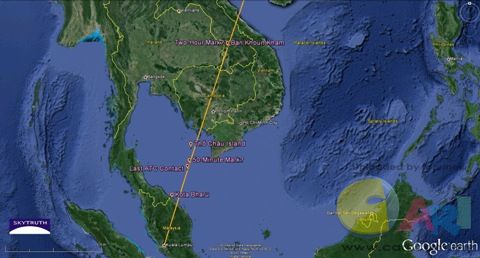PETALING JAYA: Military radar tracking has shown that the missing aircraft changed altitude after making a sharp turn over the South China Sea as it headed towards the Straits of Malacca, CNN reported. A source close to the investigation told CNN that the plane flew as low as 12,000 feet at some point before vanishing from the radar. The sharp turn would have taken the Boeing 777 two minutes to execute, said the official, and seemed to be intentional as the pilot or co-pilot could have sent an emergency signal to alert of any distress on board the plane in that period. According to the authorities, the plane did not send any emergency signals, yet it remains unclear to analysts whether the pilots tried but were not able to communicate because of a catastrophic failure. The area the plane flew in after the turn is an air corridor with heavy traffic, and flying at 12,000 feet would have kept it out of the way of that traffic. However, according to CNN, analysts are divided on the new lead, as some say it points towards sudden mechanical failure sending the plane off course, while others find that there are too many unknowns to eliminate any possibilities. Aviation analyst Miles O’Brien told CNN the new details were a “game changer”, and that the primary assumption should be that something bad happened to the plane shortly after the crew said good night. The pilots could have chosen to deliberately fly lower to save passengers onboard if a crisis on the plane had caused the aircraft to lose pressure, he said. "You want to get down to 10,000 feet, because that is when you don't have to worry about pressurization. You have enough air in the atmosphere naturally to keep everybody alive. "So part of the procedure for a rapid decompression ... it's called a high dive, and you go as quickly as you can down that to that altitude,” he added. Mary Schiavo, an aviation analyst and former inspector general for the US Department of Transportation, said the fresh details were “highly significant” as they explain many pieces that did not fit together previously. "Now, if we have a scenario where something happened, the plane made a dramatic turn and dropped from 35,000 feet to 12,000 feet, this scenario would fit what a pilot would do in the event of a catastrophic onboard event, such as a rapid decompression, a fire, an explosion. “That's what you would have to do, descend, get down and turn around and try to get back to an airport that could accommodate an ailing plane,” she added. If found accurate, it would also fit the theory of pilots trying to save the plane, said former American Airlines pilot Mark Weiss. But with the bulk of information and contradictory information at hand, it’s still a big if: “I caution against jumping to any types of conclusions at this point," he said. http://www.thestar.com.my/News/N ... -radar-CNN-reports/
|
ADVERTISEMENT